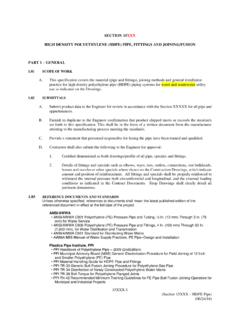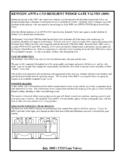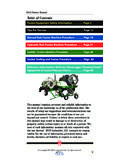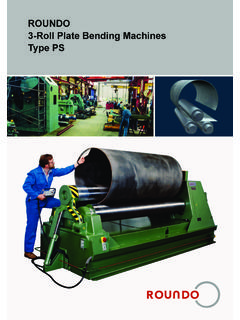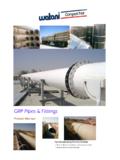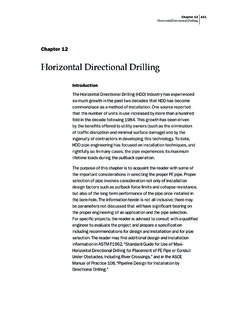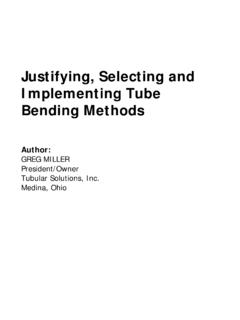Transcription of Horizontal Directional Drilling - ISCO Industries
1 Chapter 12 413. Horizontal Directional Drilling Chapter 12. Horizontal Directional Drilling Introduction The Horizontal Directional Drilling (HDD) Industry has experienced so much growth in the past two decades that HDD has become commonplace as a method of installation. One source reported that the number of units in use increased by more than a hundred- fold in the decade following 1984. This growth has been driven by the benefits offered to utility owners (such as the elimination of traffic disruption and minimal surface damage) and by the ingenuity of contractors in developing this technology.
2 To date, HDD pipe engineering has focused on installation techniques, and rightfully so. In many cases, the pipe experiences its maximum lifetime loads during the pullback operation. The purpose of this chapter is to acquaint the reader with some of the important considerations in selecting the proper polyethylene pipe . Proper selection of pipe involves consideration not only of installation design factors such as pullback force limits and collapse resistance, but also of the long-term performance of the pipe once installed in the bore-hole.
3 The information herein is not all-inclusive; there may be parameters not discussed that will have significant bearing on the proper engineering of an application and the pipe selection. For specific projects, the reader is advised to consult with a qualified engineer to evaluate the project and prepare a specification including design recommendations and pipe selection. The reader many find additional design and installation information in ASTM F1962, Standard Guide for Use of Maxi- Horizontal Directional Drilling for Placement of Polyethylene pipe or Conduit Under Obstacles, Including River Crossings, and in the ASCE Manual of Practice 108, Pipeline Design for Installation by Directional Drilling .
4 414 Chapter 12. Horizontal Directional Drilling Background Some of the earliest uses of large diameter polyethylene pipe in Directional Drilling were for river crossings. These are major engineering projects requiring thoughtful design, installation, and construction, while offering the owner the security of deep river bed cover with minimum environmental damage or exposure, and no disruption of river traffic. Polyethylene pipe is suited for these installations because of its scratch tolerance and the fused joining system which gives a zero-leak-rate joint with design tensile capacity equal to that of the pipe .
5 To date, Directional drillers have installed polyethylene pipe for gas, water, and sewer mains; electrical conduits; and a variety of chemical lines. These projects involved not only river crossings but also highway crossings and right-of-ways through developed areas so as not to disturb streets, driveways, and business entrances. Polyethylene pipe for Horizontal Directional Drilling This chapter gives information on the pipe selection and design process. It is not intended to be a primer on Directional Drilling . The reader seeking such information can refer to the references of this chapter.
6 Suggested documents are the Mini- Horizontal Directional Drilling Manual and the Horizontal Directional Drilling Good Practices Guidelines published by the North American Society for Trenchless Technology (NASTT). Horizontal Directional Drilling Process Knowledge of the Directional Drilling process by the reader is assumed, but some review may be of value in establishing common terminology. Briefly, the HDD. process begins with boring a small, Horizontal hole (pilot hole) under the crossing obstacle ( a highway) with a continuous string of steel drill rod.
7 When the bore head and rod emerge on the opposite side of the crossing, a special cutter, called a back reamer, is attached and pulled back through the pilot hole. The reamer bores out the pilot hole so that the pipe can be pulled through. The pipe is usually pulled through from the side of the crossing opposite the drill rig. Pilot Hole Pilot hole reaming is the key to a successful Directional Drilling project. It is as important to an HDD pipeline as backfill placement is to an open-cut pipeline. Properly trained crews can make the difference between a successful and an unsuccessful Drilling program for a utility.
8 Several institutions provide operator- training programs, one of which is Michigan State University's Center for Underground Infrastructure Research and Education (CUIRE). Drilling the pilot hole establishes the path of the drill rod ( drill-path ) and subsequently the location of Chapter 12 415. Horizontal Directional Drilling the PE pipe . Typically, the bore-head is tracked electronically so as to guide the hole to a pre-designed configuration. One of the key considerations in the design of the drill-path is creating as large a radius of curvature as possible within the limits of the right-of-way, thus minimizing curvature.
9 Curvature induces bending stresses and increases the pullback load due to the capstan effect. The capstan effect is the increase in frictional drag when pulling the pipe around a curve due to a component of the pulling force acting normal to the curvature. Higher tensile stresses reduce the pipe 's collapse resistance. The drill-path normally has curvature along its vertical profile. Curvature requirements are dependent on site geometry (crossing length, required depth to provide safe cover, staging site location, etc.) But, the degree of curvature is limited by the bending radius of the drill rod and the pipe .
10 More often, the permitted bending radius of the drill rod controls the curvature and thus significant bending stresses do not occur in the pipe . The designer should minimize the number of curves and maximize their radii of curvature in the right-of-way by carefully choosing the entry and exit points. The driller should also attempt to minimize extraneous curvature due to undulations (dog-legs) from frequent over- correcting alignment or from differences in the soil strata or cobbles. Pilot Hole Reaming The REAMING operation consists of using an appropriate tool to open the pilot hole to a slightly larger diameter than the carrier pipeline.

